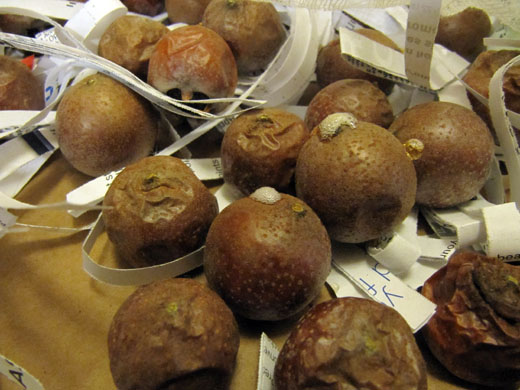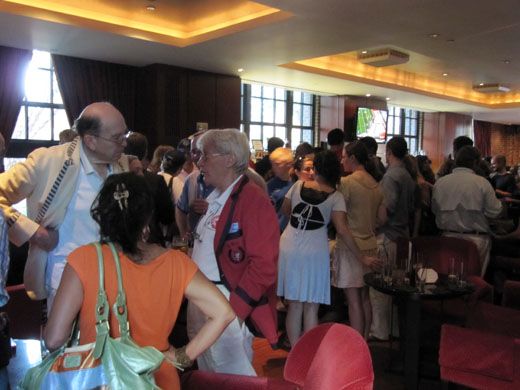Are conditions in Thai shrimp factories “medieval”? Matt Gabriele considers the use of the m-word in a report quoted by CNN:
Maybe it’s just an adjective that means “other,” an uncritical, enlightenment perception of a darker past that we, generally, have moved beyond. And generally, I might like to agree. The problem, then, is that this kind of thinking asserts that such behavior—torture, kidnapping, etc.—are aberrant in our society, when in fact they’re really not. Certainly, all that stuff was there in the Middle Ages too. The thing is though, it never left.
Matt’s conclusion—that misery and human cruelty aren’t consigned to the past—is sensible, and worth reiterating; people do have a tough time getting beyond the pejorative implications of “medieval.” My Chaucer students, for example, know that Chaucer himself was well connected, and they understand that the Powers That Be had neither the resources nor the inclination—nor, for that matter, any real reason—to persecute him for his poetry. And yet my students wonder: Feisty women, farting, harshing on friars—how did Chaucer get away with so much?
The misperception that Chaucer “got away with” something isn’t surprising; his humanity, sensibility, and wit run counter to stereotypes about those oppressive Middle Ages. It takes gentle persuasion to convince students to see Chaucer as a poet who can illuminate his era for modern readers, allowing them to put aside preconceptions and behold his world anew—and then, if they’re lucky, rediscover their own.
But sometime it’s fruitful to try the reverse: to ponder a modern subject that puts the medieval world in context. That’s why I couldn’t help but consider Chaucer recently while reading a new biography of a decidedly un-medieval figure: pioneering black filmmaker Oscar Micheaux.
Born in 1884 to former slaves, Micheaux worked as a Pullman porter before becoming a homesteader in South Dakota. He self-published and promoted three autobiographical novels; then, between 1919 and 1948, he wrote, directed, and produced more than 40 movies for black audiences. Motivated by his near-worship of Booker T. Washington and inspired by stories of self-made men, Micheaux was an entrepreneur, an auteur, a fascinating American figure.
He was also a wonderfully Chaucerian guy. Attentive to the quirks of human nature, Micheaux made films that featured, but didn’t glamorize, the black underworld, where a motley pageant of lowlifes and gamblers spouted racial epithets; he even offered the occasional hint of nudity. Micheaux dabbled in multiple genres, sometimes recombining beloved story elements in bizarre and amusing ways: a musical comedy about a haunted house, for example, or a morality play about racial segregation that also featured Alaskan frontiersmen, wild dream visions, and an assortment of scoundrels and saints. Micheaux was something of a scoundrel himself, a raconteur who traveled the country and who would happily lie, cheat, and even plagiarize to promote the few prints of his films he was able to afford. Cheerful, beguiling, optimistic, and perceptive, Oscar Micheaux was was a grand character: Chaucer’s plowman, pardoner, squire, and alchemist all rolled into one.
So yes, Micheaux was interesting—but why strain to see a connection between him and Chaucer? Because Micheaux, a modern artist, suffered “medieval” repercussions that Chaucer never experienced. Beyond having to deal with blatant racism, Micheaux faced the wrath of both church and state when his films were literally snipped to shreds. Sometimes, censors banned his films outright, denying black audiences the opportunity to see his take on black people who “passed” as white, or depictions of lynching, or—Heaven forbid—black and white people dancing together. State and local censors were often clergy who objected, naturally, to one of Micheaux’s recurring character types: the corrupt, hypocritical preacher.
Treated as a fourth-class citizen, denied the ability by clergy and government officials to show his films as he envisioned them, Micheaux was often broke, even bankrupt, and was completely ignored by the mainstream white press. Although film historians recently rediscovered him and restored a few of his movies, his persecutors can’t be said to have failed. They succeeded at suppressing him; his obscurity was their victory. Today, we have a greater percentage of Chaucer’s 14th-century corpus than we have surviving films by Oscar Micheaux, who faced the sort of institutional censorship my students expect from the medieval world, even though Micheaux died only in 1951.
“Maybe,” Matt Gabriele writes in his post about “medieval” shrimp factories, “we all should acknowledge that good stuff and bad stuff happens to all people, at all times, in all places.” That’s one of many lessons to take from the life of Micheaux. Unlike Chaucer, who had little to fear, Micheaux “got away with” much, but he suffered much as well.
If the poetry of Geoffrey Chaucer reminds us not to judge all medieval people by the worst aspects of the Middle Ages, then the career of Oscar Micheaux warns us not to judge our own era only by its best. The life story of an ambitious black filmmaker reminds us that the modern world is hardly bereft of “medieval” indignities. We live in more comfortable, prosperous times, but we ought to think twice before assuming we’ve nothing in common, really, with medieval people.
 If you’re wont to ask, “Where can I see plays that have rarely been staged for 400 years?”, then hie thyself posthaste anon to Staunton, Virginia, where the American Shakespeare Center reanimates old scripts in a reconstruction of London’s Blackfriars Theater, and under truly humbling conditions: The actors perform in as many as five plays at a time, with multiple roles in each.
If you’re wont to ask, “Where can I see plays that have rarely been staged for 400 years?”, then hie thyself posthaste anon to Staunton, Virginia, where the American Shakespeare Center reanimates old scripts in a reconstruction of London’s Blackfriars Theater, and under truly humbling conditions: The actors perform in as many as five plays at a time, with multiple roles in each.






 Christmas songs are quick to commemorate the sounds and the sights of the season, but rarely do they dwell on smells. Most people, I gather, fondly recall the fragrance of spruce needles or the cloying whiff of cookies, but this year I’ll pine for a more medieval Christmas scent: the sweet, pseudo-oenomelic aroma of tiny, rotting fruit.
Christmas songs are quick to commemorate the sounds and the sights of the season, but rarely do they dwell on smells. Most people, I gather, fondly recall the fragrance of spruce needles or the cloying whiff of cookies, but this year I’ll pine for a more medieval Christmas scent: the sweet, pseudo-oenomelic aroma of tiny, rotting fruit.











